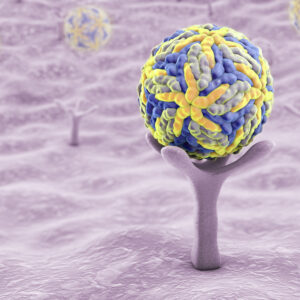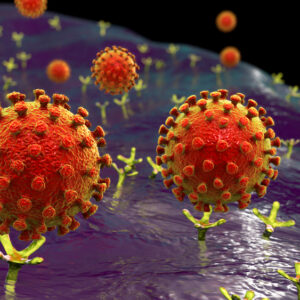Retrovirus Receptors
The Native Antigen Company manufacturers Retrovirus receptors using state-of-the-art expression and purification techniques. Custom preparation of recombinant and native proteins for a broad range of disease states is also available upon request.
Retrovirus Receptors Background
Retroviruses comprise a large and diverse family of enveloped positive-sense RNA viruses (7-12 kb ssRNA[+] genome) that replicate in a host cell through the process of reverse transcription, after gaining entry by a variety of host-encoded retrovirus receptors. The different genuses of retrovirus virions have diverse morphology, but they are defined by common taxonomic denominators, including structure, composition and replicative properties (Coffin 1992, 1996). Retroviridae is subdivided into Orthoretrovirinae and Spumaretrovirinae. Retroviruses are further subdivided into seven groups defined by evolutionary relatedness, each with the taxonomic rank of genus.
Within Orthoretrovirinae the various genus are;
- Alpharetrovirus (Rous sarcoma virus, avian sarcoma leukosis virus)
- Betaretrovirus (Mouse mammary tumor virus, Jaagsiekte sheep retrovirus)
- Gammaretrovirus (murine leukemia virus, Abelson murine leukemia virus, Friend virus, koala retrovirus, xenotropic murine leukemia-related virus)
- Deltaretrovirus (Human/primate T-lymphotropic virus (HTLV) types 1–4, simian T-lymphotropic virus types 1–4, Bovine leukemia virus)
- Epsilonretrovirus (Walleye epidermal hyperplasia virus)
- Lentivirus (human immunodeficiency virus (HIV), simian immunodeficiency viruses (SIV), feline immunodeficiency virus, puma lentiviruses, bovine immunodeficiency virus, caprine arthritis encephalitis virus, visna virus) are present.
Within Spumaretrovirinae only one genus is present;
- Spumavirus (simian foamy virus, human foamy virus)
Five of these groups represent retroviruses with oncogenic potential (oncoviruses), and the other two groups are the lentiviruses and the spumaviruses. They are classified into two types, simple and complex, based on their RNA genome structure: the RNA genome of simple retrovirus contains only three essential genes, gag, pol, and env whereas that of complex retrovirus contains additional gene(s). All oncogenic members except the human T-cell leukemia virus–bovine leukemia virus (HTLV-BLV) genus are simple retroviruses. HTLV-BLV and the lentiviruses and spumaviruses are complex.
Most retroviruses infect dividing cells during mitosis, when the chromatin is exposed to the cytoplasm. However, the genus of Lentiviruses, including the human immunodeficiency virus (HIV), have evolved to infect non-dividing cells. Retrovirus infection requires entry into host cells, reverse transcription, integration, expression of viral genes, and production of viral particles. At each step, retroviruses utilize the host machinery for their propagation.
The retrovirus particle is spherical and 80-100 nm in diameter. It consists of the inner core and the outer envelope. The core contains two copies of a plus strand of the viral RNA genome and viral proteins, such as capsid (encoded by gag) and reverse transcriptase (encoded by pol), whereas the envelope consists of the viral coat proteins (encoded by env) and the lipid bilayer derived from the host cells.
Retroviruses enter the host cell through the attachment of their surface glycoproteins to specific plasma membrane receptors, which leads to fusion of virus and cell membranes. The virus envelope consists of lipids that are obtained from the host plasma membrane during the budding process including glycoproteins gp120 and gp41 in the case of HIV. The envelope glycoprotein complex of retroviruses includes two polypeptides, an external, glycosylated hydrophilic polypeptide (SU) and a membrane-spanning protein (TM), that together form an oligomeric knob or knobbed spike on the surface of the virion. Both polypeptides are encoded by the env gene and are synthesized in the form of a polyprotein precursor that is proteolytically cleaved during its transport to the surface of the cell. The SU domain binds to a specific receptor molecule on the target cell, which appears to activate the membrane fusion-inducing potential of the TM protein and the viral and cell membranes then fuse. Activation of the fusion potential of the TM protein requires a functional association between the receptor and SU and it is likely that several glycoprotein/receptor oligomers must associate within the plane of the membrane for an effective “fusion-pore” to form. The specificity of the SU/receptor interaction defines the host range and tissue tropism of a retrovirus; viral particles lacking envelope glycoproteins are non-infectious, and cells lacking a receptor are nonpermissive for viral entry. Viruses may bind weakly but in the absence of a specific receptor molecule, they are unable to initiate the infection process.
The receptors for retroviral entry that have been identified and characterized to date appear to be distinct for the different major viral subgroups; for example, the CD4 antigen found on T-helper cells is a high-affinity receptor molecule for HIV and SIV whereas murine and feline leukemia viruses require three different membrane transporter molecules.
Retroviral infections can lead to diseases such as cancer and immunodeficiency in many species, including humans. In addition, retroviruses are used as gene delivery vehicles because the DNA form of the viral genome becomes an integrated part of the host cell genome. Therefore, there is considerable interest in defining the functional interactions between retroviral envelope proteins and retrovirus receptors.
References
- Coffin J.M. 1992a. Structure and classification of retroviruses. In The retroviridae (ed. J.A. Levy), pp. 19–49. Plenum Press, New York
- Coffin J.M. Genetic diversity and evolution of retroviruses. Top. Microbiol. Immunol. 1992b; 176:143–164.
- Coffin J.M. 1996. Retroviridae and their replication In Virology (ed. B.N. Fields et al.), pp. 1767–1848. Raven Press, New York.
- Coffin JM, Hughes SH, Varmus HE, editors. Retroviruses. Cold Spring Harbor (NY): Cold Spring Harbor Laboratory Press; 1997.
- Shailendra K. Saxena and Sai V. Chitti. Molecular Biology and Pathogenesis of Retroviruses. March 16th 2016. IntechOpen.
- Sommerfelt M. A. (1999). Retrovirus receptors. Journal of General Virology, 80, 3049–3064.
Retrovirus Receptors
The Native Antigen Company is pleased to offer highly purified recombinant Retrovirus receptor proteins.
Questions?
Check out our FAQ section for answers to the most frequently asked questions about our website and company.



